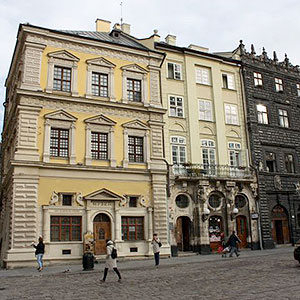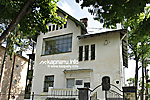IVAN TRUSH Memorial Museum of Arts
National Museum Department
A constant exposition which is presented in Ivan Trush Memorial Museum of Arts demonstrates the whole multiformity of the artist's personality. Two-storey villa in late Secession style was founded in former Obvodova street (nowadays — Ivan Trush street) according to the project of Lviv architect Oleksandr Lushpynsky. The artist with his family lived there since 1910 till 1941.
After the artist's death his daughter Ariadna Trush-Slonevska took care of the house, in 1951 she organized the constant exhibition in her father's workroom, then the artist's children (Ariadna and Roman) devised that house to the Ukrainians in the face of Lviv National Museum, it owns the biggest collection of Ivan Trush's works. Nowadays over fifty works are exhibited in the Memorial Museum of Arts, officially it starts its work in 1989 year.
Exposition is built up to thematic chronological principle and it represents basic pages of Ivan Trush's life and creative work. Pictorial canvases enlighten the artist's painting talent, archival documents and still pictures show up the artist's formation period as an active public man, critic and as a popularizer of Ukrainian culture.
In three rooms on the ground floor one of the earliest works of Ivan Trush is displayed (Nude old man studio, 1897), it is from his studying in Krakow period and the best examples of his portrait works: Ivan Franko portrait (1940), Ivan Nechuy-Levitsky portrait (1900), Volodymyr Antonovych portrait (1900), Mykhaylo Hrushevsky portrait (1900), Mykhaylo Dragomanov and Sylvestr Sembratovych cardinal portraits (1899). The portraits of the artist's family are of a great value, among them his wife's Ariadna portrait (1904).
On the first floor in the spacious studio, designed according to Trush's project, landscape painting works from the artist's collection are represented. Cypresses and Clouds pictures from the Crimean series which had been being created during four decades under the author's impression from his travellings to the Crimea (1901, 1903, 1904).
Many Italian landscapes with the examples of the ancient architecture, small studies with stone-pines and cypresses, Via Appiya series of pictures with the views of the Roman old road are the results of the artist's travellings to Rome (1902) and Venice (1908).
Arabian motives with the southern countries nature picturing had been created during Trush's two months staying in Egypt and Palestine (1912). Those works are interesting because of their subject and painting techniques and they are characterised by the colours range continence. In the exposition this subject is enlightened in such works as Sfinks (1928), Evening scenery with the Jordan river, the Arabian near the village, the Olive trees (1928) and the Bedouin in oasis (1912), the artist excellently reproduced life in the desert.
The special place in the artist's pictorial heritage belongs to the works with native nature picturing. A special spirit is in Galician evening landscapes such as: the Solitary grave, the Mill in the night and the Sunset in Bryukhovychi. The author demonstrates Hutsulian traditions and the Ukrainian Carpathians nature in subject compositions from Our life series (Jordan in Hutsul land, the Village boy, Spring in Hutsul land, Hutsul women near the church etc).
Students — 10 UAH
Pupils, pensioners — 8 UAH
Adults — 50 UAH
Students — 40 UAH
Pupils, pensioners — 30 UAH

 Ukraine
Ukraine Poland
Poland Slovakia
Slovakia
 Українською
Українською




















































































































